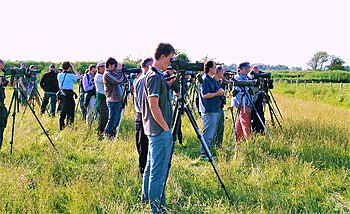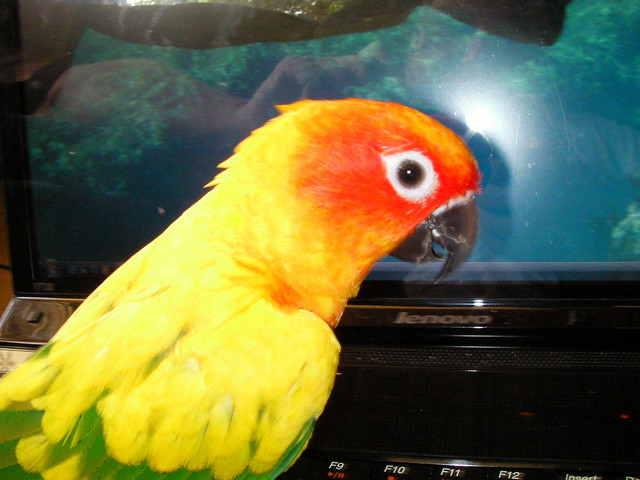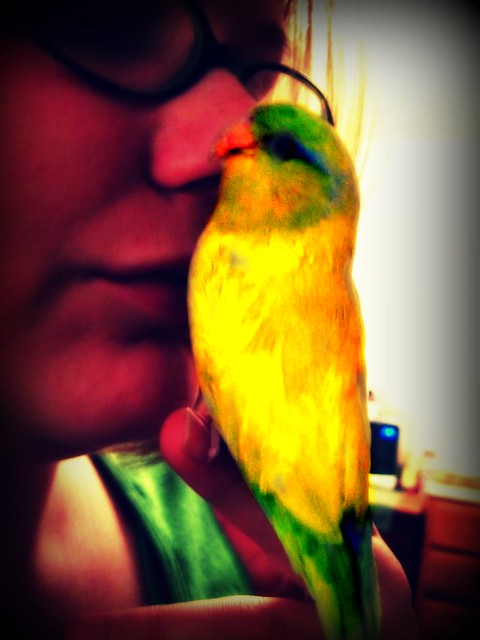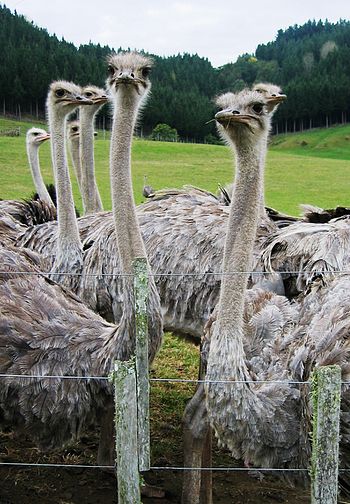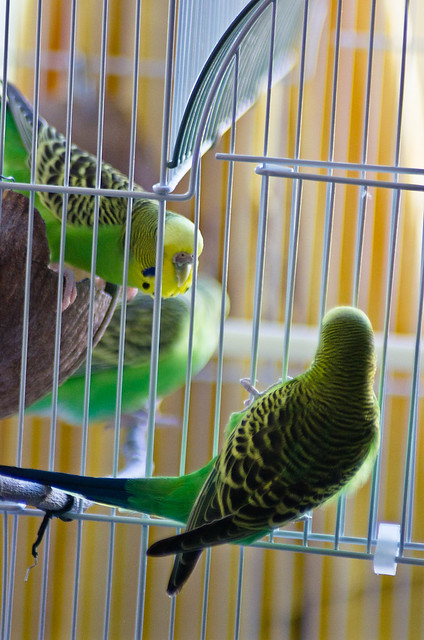 |
| Budgie Cage - Photo by Kurayba (cc) |
If you don't have fine sandpaper to cover the floor, you can spread out under the layer of very fine ballast (or very coarse sand ) and an ordinary newspaper, which must not have colored illustrations. Most printing inks are poisonous for budgies. Something more that can threaten your birds is using twigs from the coniferous tree – yew, whose wood is also poisonous for birds. It is best for this purpose to use twigs from orchard trees.
WHAT DO THEY NEED?
My recommendation is to use transparent feeders – thus it will be easier for the budgie to find its food when it sees the food. Feeders must be of two types – one for seeds and sand with stones and another bigger one for the vegetation and fruit. The sand could be from the sea, mixed with crushed shells and mussels ( but not from the white one that is sold for the Canaries), and the stones should be from granite or flint. Budgies get bored with the same toys, so it is better to change or to take turns of them into the cage. It is considered that a mirror makes the loneliness of the bird more endurable – looking into the mirror the bird start imagining that it is not alone, but I consider that constant looking in the mirror is not recommendable because of a danger of inhibition.
Choose the most spacious cage, which you can afford and which you can dispose at home. It is considered that the ideal size of cage for a couple of budgies is 91/45/45 cm, and when only one bird is going to live in the cage its size could be 2/3 from the stated one. Don't be in a hurry with you purchase – many cages are sold in the zoo shops, but you can have the chance to buy a suitable already used one. Different constructions exist, so it is sensible not to hurry so that you can buy something really good. You buy a home for your budgies, where their life will pass, so do your best to choose such, where they will feel best. Choosing a cage it is not bad to think about some things.
Is it spacious enough? Is its shape proper – you might like a high circular cage, but in “ lodgings ” birds very often don't have enough room to move and to outspread their wings. It can seem less important, but closing the door must be secure. There should be a mobile plastic bottom in the cage, which to ease cleaning it. The sticks of the cage can be chromium plated or glazed and it is good to have horizontal not only vertical sticks on the sides of the cage so that the budgies can climb easily. The perches must be located so that birds can reach all feeders and watering troughs and place one higher than the other ones. Don't install them near the sides of the cage, because staying on them, budgies will constantly rub their tails on the metal sticks. Prepare the cage before buying your feathery friend. And when you take it from the shop, put it in a cardboard box, handle it with care and quickly take it home.
If it is cold outside wrap the box, but so that you don't reduce air flow. At hoe wash the whole cage with very hot water, but neither use soap nor washing detergents, use only special disinfection means, that are intended for birdcages. This is absolutely compulsory if you have obtained a used cage. Dry very well the new home of the bird. Place a sheet of very fine sandpaper on the bottom and spread fine ballast. After that, install the perches, feeders and water troughs.
Birds don't like the location of the cage to be often changed, that is why choose the most proper place for them in your flat right in the beginning. The place should be lighted up enough, but not to be lit up directly by sunlight. If you have a glassed balcony from late spring to early autumn you can keep your birds there. You can put pots with big - leaved plants around the cage. Thus birds will feel well. The balcony should not be facing south, because during the hot summer days the bird can die of overheating. When temperatures get lower you should bring the bird inside the flat Watch out not to put it near the central-heating or other heating devices because air is drier there. When you bring the birds in be careful because of the make lots of mess around especially when they start flying in the cage.
It is known that budgies like to have company – your feathery pet will feel best in the room where the whole family gathers. Choose a room, where you can let the bird fly free –this is very important for its education. Budgies also need fresh air – that is why the room should not be stifling. Exactly because of this reason the cage of the birds should not be put in the kitchen as some beginners do. The steam that appears when cooking is harmful to birds. Except for that, it is very dangerous when flying in the kitchen the budgie to have a tragic end.
The cage should not be put in front of the window – there the sensitive feathery creatures very sensibly feel the atmosphere changes – the cold in winter and the burning sunrays in summer. The cage should not be exposed to draughts, very close to the radiator of the central heating or near the fireplace. Whether the cage is placed on a special for this purpose rack is not very important – it could be placed on every solid table or shelf. But on a special rack the cage takes less space, it can be put higher, which the birds will like and it will be easier to move it.
Budgies suffer if they don't sleep enough. That is why you should cover their cage with a light material – it reduces light, but birds don't stay in full darkness.

